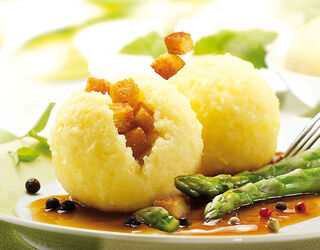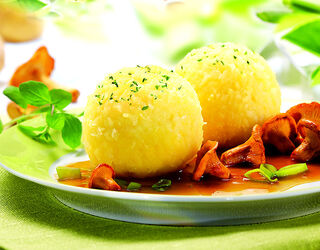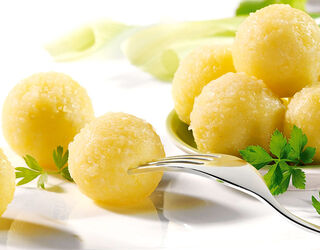Thuringian Kloesse - Dumplings
![[Translate to English:] Thüringer Klöße, Foto: Petra Hermann](/fileadmin/Redaktion/_processed_/a/d/csm_Thueringer-Kloese_-Foto-Petra-Hermann_a25224ac30.jpg)
The Sunday Ritual
From Petra Hermann
Thüringer Klöße dumplings have a long tradition, with the first written recipe by the parish of Effelder near Sonneberg dating back to 1808.
The dumplings were a Sunday ritual for us, and often played the lead role on our plates. They would be served religiously on this most wonderful day of the week, with another piece of meat and, of course, lots of sauce. And it really was every Sunday, in keeping with the saying “A Sunday without dumplings is not a great day at all”. On Saturday evenings, with Hans-Joachim Kuhlenkampff’s entertainment show on the television, Dad would head to the cellar to collect a bucketful of the largest potatoes.
Once the potatoes had been peeled, we had a lovely tradition of trying a piece of the Sunday cake which had been backed that afternoon. Then it was off to bed for us all; the potatoes would be waiting for Sunday morning. My father was once again the star of the show in act two. He would go and fetch the grater, and grate the prepared potatoes into a large bowl. Not too coarse, not too fine. The gratings were then poured into a mesh potato sack, and placed between the two wooden slabs of the potato press, before the wheel was turned, removing the liquid from the gratings.
The process would occasionally need to be repeated. But after a good hour or so, it was enough; the liquid would separate from the potato starch, be decanted, and then used to brush suits or costumes, making them look “as good as new”, as my mother would say!
When grating the potatoes, there would always been some small pieces left over. These would be boiled soft in a pot with a bit of saltwater, and then mashed. Salt would be added to the potato mixture in the bowl, before everything was then scalded together with the resulting thinly mashed potato and quickly combined. The ratio of raw to cooked was around 3/4 to 1/4.
Whatever bread was available would be cut into small cubes and fried in butter until crispy. Five or six of these cubes would be inserted into the dumplings as these were being formed by damp hands. The dumplings would then be placed in boiling saltwater, and the heat would be instantly lowered. They would soon rise to the top, and had to be left there to simmer for around 30 minutes, without actually boiling.
Anzeigen


